Potential Use of Time-Lapse Surface Seismics for Monitoring Thawing of the Terrestrial Arctic
Abstract
:Featured Application
Abstract
1. Introduction
2. Materials and Methods
2.1. Modeling Thawing of Frozen Sediments
2.2. Modeling Effects of Thawing on Seismic Properties
2.3. Surface Seismic Analysis
3. Results
3.1. Synthetic Seismic Data
3.2. Real Seismic Data Example
4. Discussion and Conclusions
Author Contributions
Funding
Conflicts of Interest
Appendix A
References
- Christiansen, H.H.; Etzelmüller, B.; Isaksen, K.; Juliussen, H.; Farbrot, H.; Humlum, O.; Johansson, M.; Ingeman-Nielsen, T.; Kristensen, L.; Hjort, J. The thermal state of permafrost in the Nordic area during the International Polar Year 2007–2009. Permafr. Periglac. Process. 2010, 21, 156–181. [Google Scholar] [CrossRef] [Green Version]
- Pachauri, R.K.; Allen, M.R.; Barros, V.R.; Broome, J.; Cramer, W.; Christ, R.; Church, J.A.; Clarke, L.; Dahe, Q.; Dasgupta, P. Climate Change 2014: Synthesis Report. Contribution of Working Groups I, II and III to the Fifth Assessment Report of the Intergovernmental Panel on Climate Change; 9291691437; IPCC: Geneva, Switzerland, 2014. [Google Scholar]
- French, H.M. The Periglacial Environment, 5th ed.; John Wiley & Sons: West Sussex, UK, 2017. [Google Scholar]
- Hjort, J.; Karjalainen, O.; Aalto, J.; Westermann, S.; Romanovsky, V.E.; Nelson, F.E.; Etzelmüller, B.; Luoto, M. Degrading permafrost puts Arctic infrastructure at risk by mid-century. Nat. Commun. 2018, 9, 5147. [Google Scholar] [CrossRef] [PubMed]
- Zimmerman, R.W.; King, M.S. The effect of the extent of freezing on seismic velocities in unconsolidated permafrost. Geophysics 1986, 51, 1285–1290. [Google Scholar] [CrossRef]
- Schaefer, K.; Zhang, T.; Bruhwiler, L.; Barrett, A.P. Amount and timing of permafrost carbon release in response to climate warming. Tellus B Chem. Phys. Meteorol. 2011, 63, 168–180. [Google Scholar] [CrossRef]
- Kneisel, C.; Hauck, C.; Fortier, R.; Moorman, B. Advances in geophysical methods for permafrost investigations. Permafr. Periglac. Process. 2008, 19, 157–178. [Google Scholar] [CrossRef]
- Wu, Y.; Nakagawa, S.; Kneafsey, T.J.; Dafflon, B.; Hubbard, S. Electrical and seismic response of saline permafrost soil during freeze-Thaw transition. J. Appl. Geophys. 2017, 146, 16–26. [Google Scholar] [CrossRef]
- Potter, R.W.; Clynne, M.A.; Brown, D.L. Freezing point depression of aqueous sodium chloride solutions. Econ. Geol. 1978, 73, 284–285. [Google Scholar] [CrossRef]
- Wu, Y.; Hubbard, S.S.; Ulrich, C.; Wullschleger, S.D. Remote monitoring of freeze–thaw transitions in Arctic soils using the complex resistivity method. Vadose Zone J. 2012, 12, vzj2012.0062. [Google Scholar] [CrossRef]
- Dou, S.; Nakagawa, S.; Dreger, D.; Ajo-Franklin, J. A rock-physics investigation of unconsolidated saline permafrost: P-wave properties from laboratory ultrasonic measurements. Geophysics 2016, 81, WA233–WA245. [Google Scholar] [CrossRef]
- Johansen, T.A.; Digranes, P.; van Schaack, M.; Lønne, I. Seismic mapping and modeling of near-surface sediments in polar areas. Geophysics 2003, 68, 566–573. [Google Scholar] [CrossRef]
- Park, C.B.; Miller, R.D.; Xia, J. Multichannel analysis of surface waves. Geophysics 1999, 64, 800–808. [Google Scholar] [CrossRef] [Green Version]
- Dou, S.; Ajo-Franklin, J.B. Full-wavefield inversion of surface waves for mapping embedded low-velocity zones in permafrost. Geophysics 2014, 79, EN107–EN124. [Google Scholar] [CrossRef] [Green Version]
- Strobbia, C.; Glushchenko, A.; Laake, A.; Vermeer, P.; Papworth, T.; Ji, Y. Arctic near surface challenges: The point receiver solution to coherent noise and statics. First Break 2009, 27, 69–76. [Google Scholar]
- Tsuji, T.; Johansen, T.A.; Ruud, B.O.; Ikeda, T.; Matsuoka, T. Surface-wave analysis for identifying unfrozen zones in subglacial sediments. Geophysics 2012, 77, EN17–EN27. [Google Scholar] [CrossRef]
- Ajo-Franklin, J.; Dou, S.; Daley, T.; Freifeld, B.; Robertson, M.; Ulrich, C.; Wood, T.; Eckblaw, I.; Lindsey, N.; Martin, E. Time-lapse surface wave monitoring of permafrost thaw using distributed acoustic sensing and a permanent automated seismic source. In SEG Technical Program Expanded Abstracts 2017; Society of Exploration Geophysicists: Tulsa, OK, USA, 2017; pp. 5223–5227. [Google Scholar]
- Romanovsky, V.E.; Osterkamp, T.E. Effects of unfrozen water on heat and mass transport processes in the active layer and permafrost. Permafr. Periglac. Process. 2000, 11, 219–239. [Google Scholar] [CrossRef]
- Weismüller, J.; Wollschläger, U.; Boike, J.; Pan, X.; Yu, Q.; Roth, K. Modeling the thermal dynamics of the active layer at two contrasting permafrost sites on Svalbard and on the Tibetan Plateau. Cryosphere 2011, 5, 741–757. [Google Scholar] [CrossRef] [Green Version]
- Seneviratne, S.I.; Donat, M.G.; Pitman, A.J.; Knutti, R.; Wilby, R.L. Allowable CO 2 emissions based on regional and impact-related climate targets. Nature 2016, 529, 477. [Google Scholar] [CrossRef] [Green Version]
- Govaerts, J.; Beerten, K.; Veen, J.T. Weichselian permafrost depth in the Netherlands: A comprehensive uncertainty and sensitivity analysis. Cryosphere 2016, 10, 2907–2922. [Google Scholar] [CrossRef] [Green Version]
- De Vries, D.A. Thermal properties of soils. In Physics of Plant Environment; North-Holland Publishing Corporation: Amsterdam, The Netherlands, 1963; pp. 210–235. [Google Scholar]
- Pryor, R.W. Multiphysics Modeling Using COMSOL®: A First Principles Approach, 1st ed.; Jones & Bartlett Publishers: Sudbury, MA, USA, 2009. [Google Scholar]
- Mavko, G.; Mukerji, T.; Dvorkin, J. The Rock Physics Handbook, 2nd ed.; Cambridge University Press: New York, NY, USA, 2009. [Google Scholar]
- Dvorkin, J.; Nur, A. Elasticity of high-porosity sandstones: Theory for two North Sea data sets. Geophysics 1996, 61, 1363–1370. [Google Scholar] [CrossRef]
- Dvorkin, J.; Nur, A.; Yin, H. Effective properties of cemented granular materials. Mech. Mater. 1994, 18, 351–366. [Google Scholar] [CrossRef]
- Dvorkin, J.; Berryman, J.; Nur, A. Elastic moduli of cemented sphere packs. Mech. Mater. 1999, 31, 461–469. [Google Scholar] [CrossRef]
- Minshull, T.; Singh, S.; Westbrook, G. Seismic velocity structure at a gas hydrate reflector, offshore western Colombia, from full waveform inversion. J. Geophys. Res. Solid Earth 1994, 99, 4715–4734. [Google Scholar] [CrossRef]
- Dou, S.; Nakagawa, S.; Dreger, D.; Ajo-Franklin, J. An effective-medium model for P-wave velocities of saturated, unconsolidated saline permafrost. Geophysics 2017, 82, EN33–EN50. [Google Scholar] [CrossRef]
- Mindlin, R. Compliance of elastic bodies in contact. J. Appl. Mech. ASME 1949, 16, 259–268. [Google Scholar]
- Gassmann, F. Elastic waves through a packing of spheres. Geophysics 1951, 16, 673–685. [Google Scholar] [CrossRef]
- Berryman, J.G. Long-wavelength propagation in composite elastic media II: Ellipsoidal inclusions. J. Acoust. Soc. Am. 1980, 68, 1820–1831. [Google Scholar] [CrossRef]
- Berryman, J.G. Long-wavelength propagation in composite elastic media I: Spherical inclusions. J. Acoust. Soc. Am. 1980, 68, 1809–1819. [Google Scholar] [CrossRef]
- Hashin, Z.; Shtrikman, S. A variational approach to the theory of the elastic behaviour of multiphase materials. J. Mech. Phys. Solids 1963, 11, 127–140. [Google Scholar] [CrossRef]
- Stemland, H.M.; Johansen, T.A.; Ruud, B.O.; Mavko, G. Elastic properties as indicators of heat flux into cold near-surface arctic sediments. Geophysics. under review.
- Landau, L.D.; Kosevich, A.; Pitaevskii, L.P.; Lifshitz, E.M. Theory of Elasticity, 3rd ed.; Butterworth-Heinemann: Oxford, UK, 2012. [Google Scholar]
- Zhang, S.X.; Chan, L.S.; Chen, C.Y.; Dai, F.C.; Shen, X.K.; Zhong, H. Apparent phase velocities and fundamental-mode phase velocities of Rayleigh waves. Soil Dyn. Earthq. Eng. 2003, 23, 563–569. [Google Scholar] [CrossRef]
- Pan, Y.; Xia, J.; Gao, L.; Shen, C.; Zeng, C. Calculation of Rayleigh-wave phase velocities due to models with a high-velocity surface layer. J. Appl. Geophys. 2013, 96, 1–6. [Google Scholar] [CrossRef]
- Park, C.B.; Miller, R.D.; Xia, J. Imaging dispersion curves of surface waves on multi-channel record. In SEG Technical Program Expanded Abstracts 1998; Society of Exploration Geophysicists: Tulsa, OK, USA, 1998; pp. 1377–1380. [Google Scholar]
- Schmidt, H.; Jensen, F.B. A full wave solution for propagation in multilayered viscoelastic media with application to Gaussian beam reflection at fluid–solid interfaces. J. Acoust. Soc. Am. 1985, 77, 813–825. [Google Scholar] [CrossRef]
- Herrmann, R.B. Computer programs in seismology: An evolving tool for instruction and research. Seismol. Res. Lett. 2013, 84, 1081–1088. [Google Scholar] [CrossRef]
- Braathen, A.; Bælum, K.; Christiansen, H.H.; Dahl, T.; Eiken, O.; Elvebakk, H.; Hansen, F.; Hanssen, T.H.; Jochmann, M.; Johansen, T.A. The Longyearbyen CO 2 Lab of Svalbard, Norway—Initial assessment of the geological conditions for CO2 sequestration. Nor. J. Geol. Nor. Geol. Foren. 2012, 92, 353–376. [Google Scholar]
- Gilbert, G.L.; O‘Neill, H.B.; Nemec, W.; Thiel, C.; Christiansen, H.H.; Buylaert, J.P. Late Quaternary sedimentation and permafrost development in a Svalbard fjord-valley, Norwegian high Arctic. Sedimentology 2018, 65, 2531–2558. [Google Scholar] [CrossRef]
- Haskell, N.A. A note on air-coupled surface waves. Bull. Seismol. Soc. Am. 1951, 41, 295–300. [Google Scholar]
- O‘Neill, A.; Matsuoka, T. Dominant higher surface-wave modes and possible inversion pitfalls. J. Environ. Eng. Geophys. 2005, 10, 185–201. [Google Scholar] [CrossRef]
- Tokimatsu, K.; Tamura, S.; Kojima, H. Effects of multiple modes on Rayleigh wave dispersion characteristics. J. Geotech. Eng. 1992, 118, 1529–1543. [Google Scholar] [CrossRef]
- Lu, L.; Wang, C.; Zhang, B. Inversion of multimode Rayleigh waves in the presence of a low-velocity layer: Numerical and laboratory study. Geophys. J. Int. 2007, 168, 1235–1246. [Google Scholar] [CrossRef] [Green Version]
- Ryden, N.; Lowe, M.J. Guided wave propagation in three-layer pavement structures. J. Acoust. Soc. Am. 2004, 116, 2902–2913. [Google Scholar] [CrossRef]
- Xia, J.; Miller, R.D.; Park, C.B.; Tian, G. Inversion of high frequency surface waves with fundamental and higher modes. J. Appl. Geophys. 2003, 52, 45–57. [Google Scholar] [CrossRef]
- Zhang, S.X.; Chan, L.S. Possible effects of misidentified mode number on Rayleigh wave inversion. J. Appl. Geophys. 2003, 53, 17–29. [Google Scholar] [CrossRef]
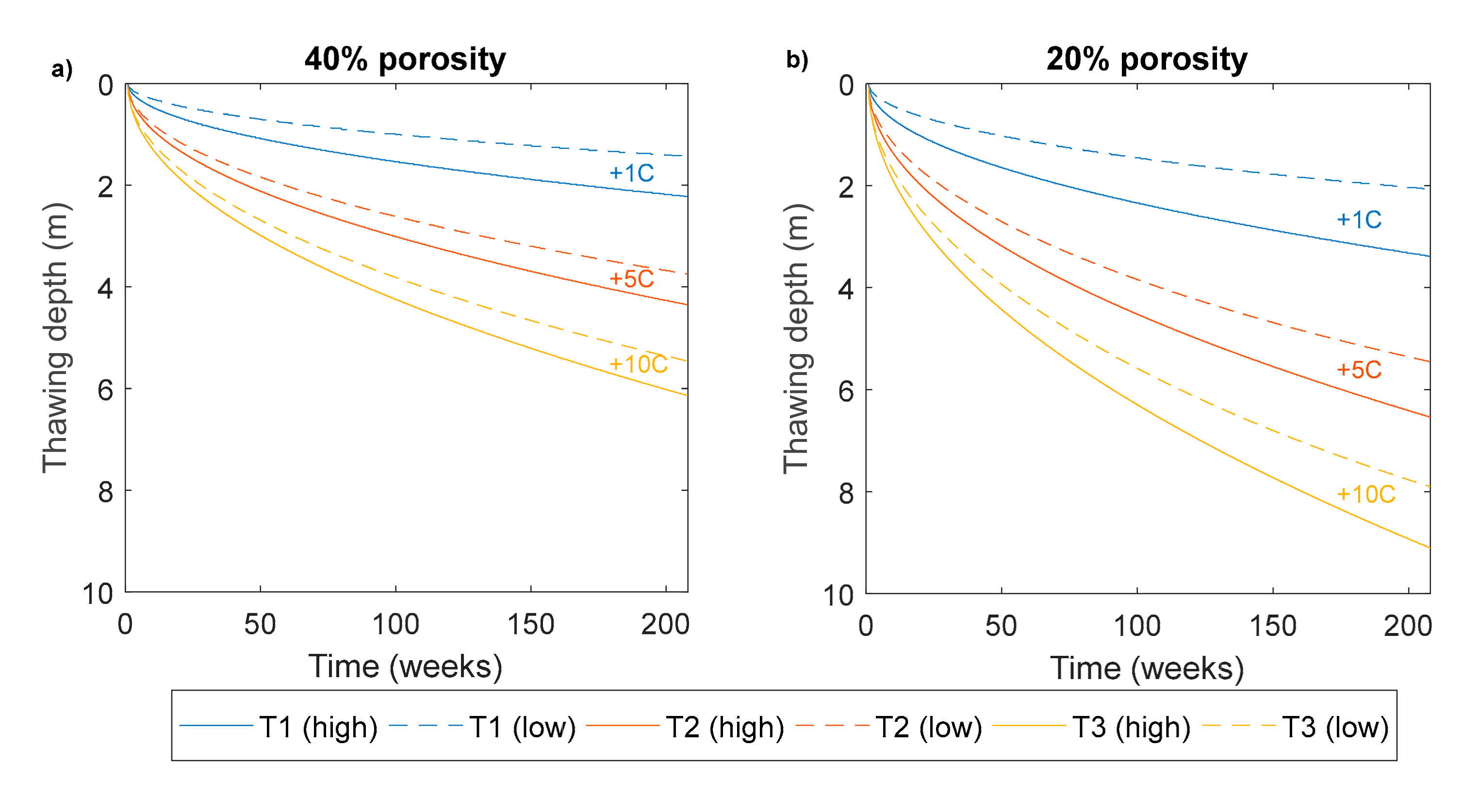
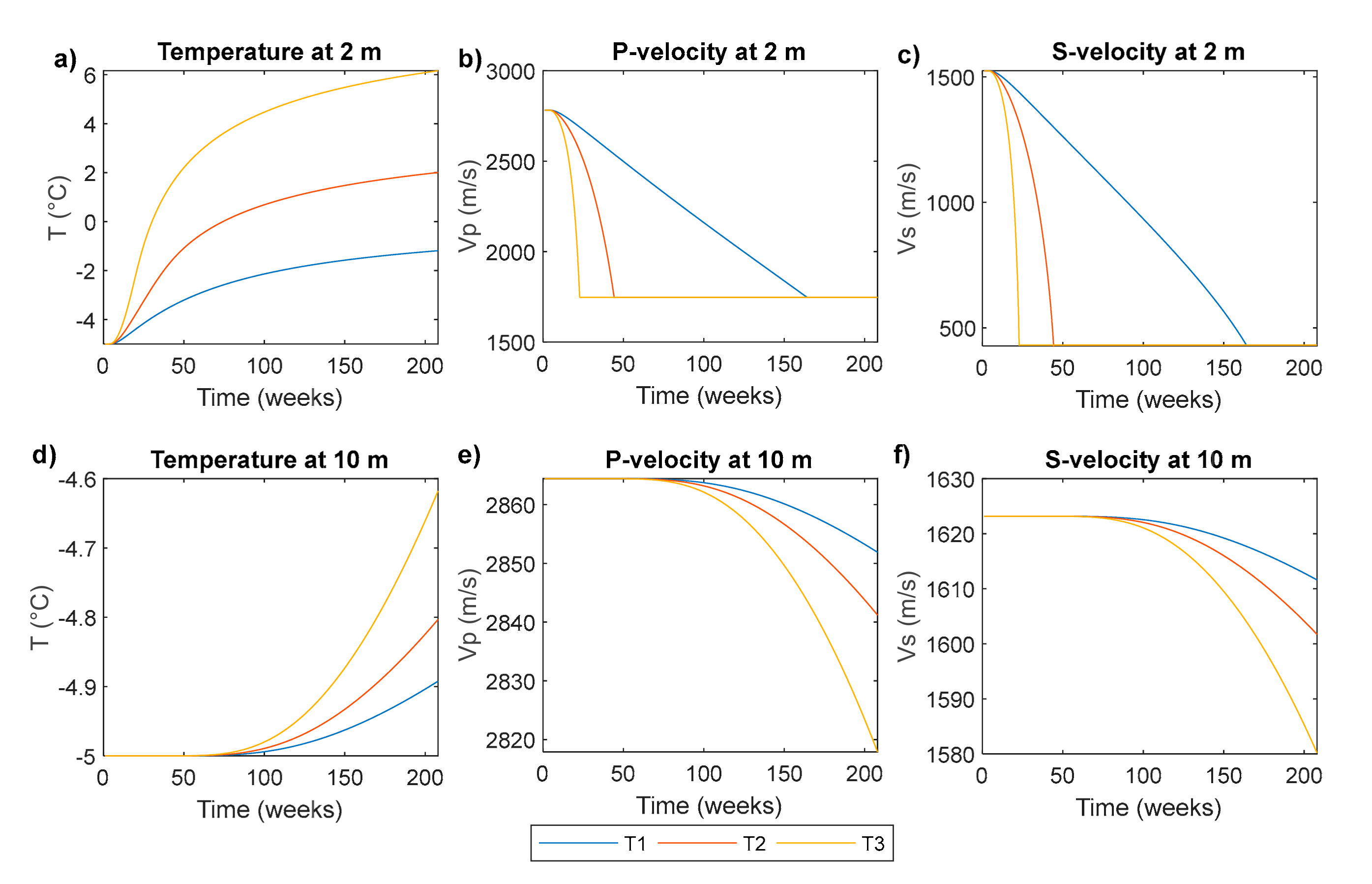
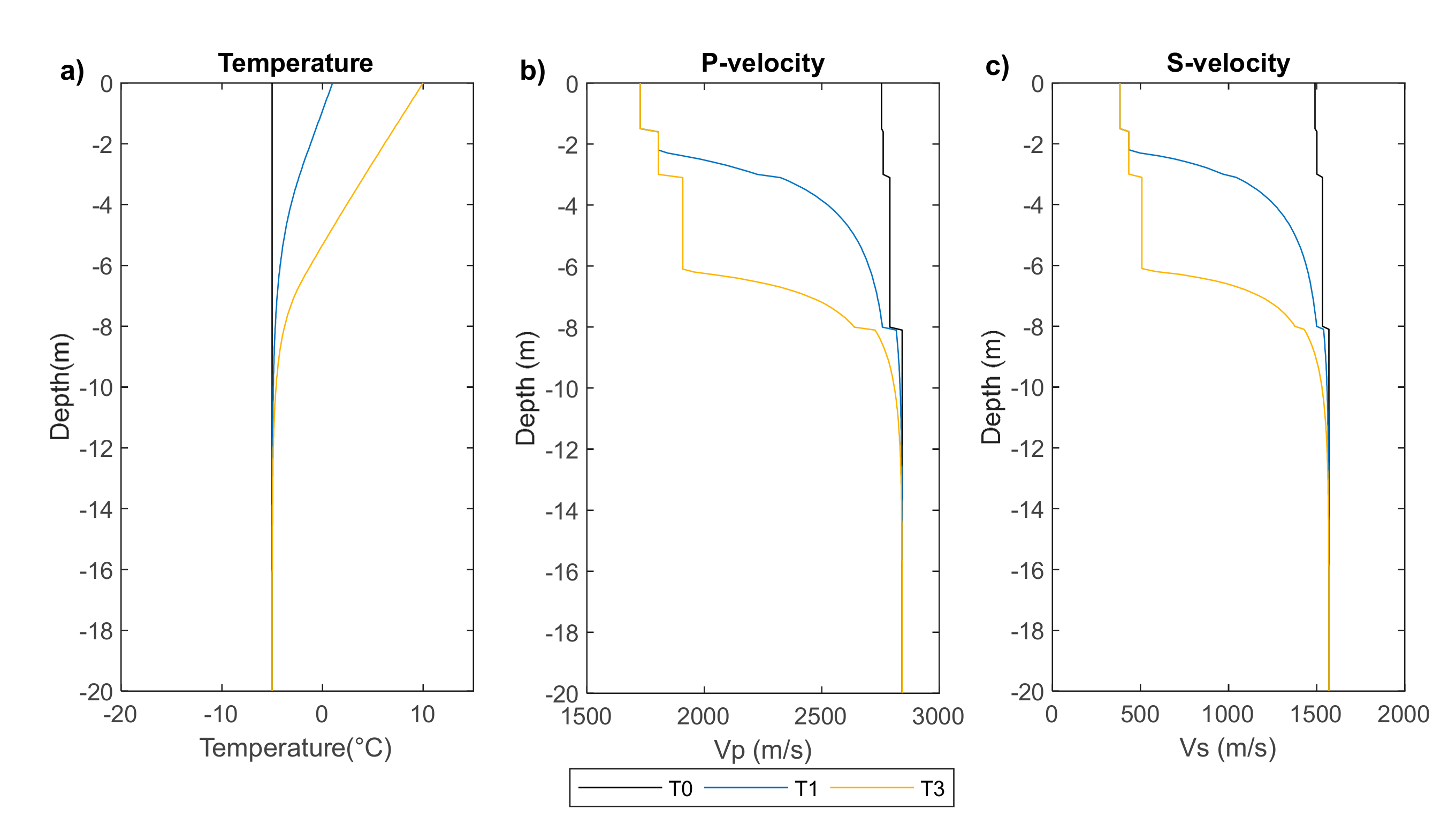
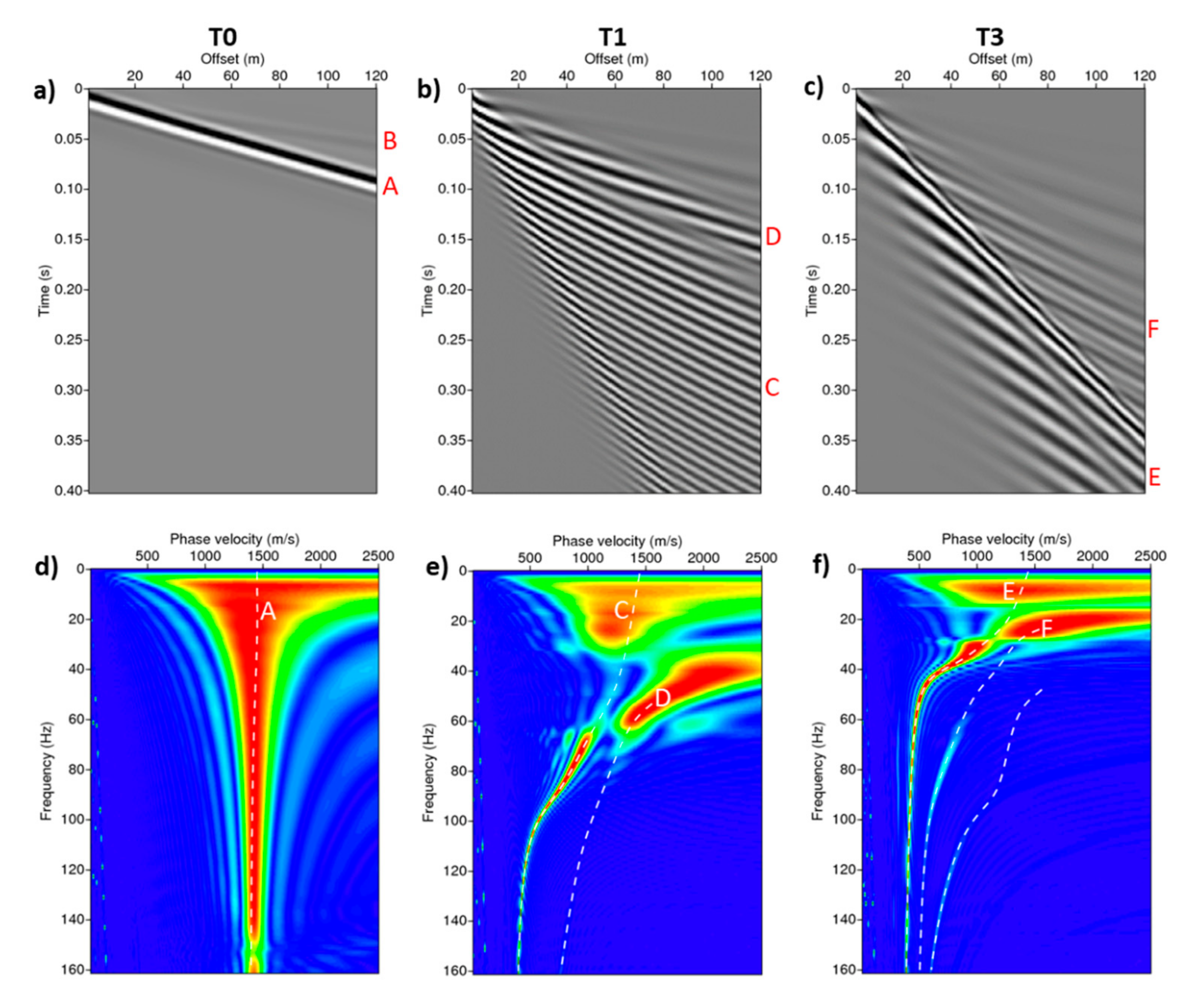


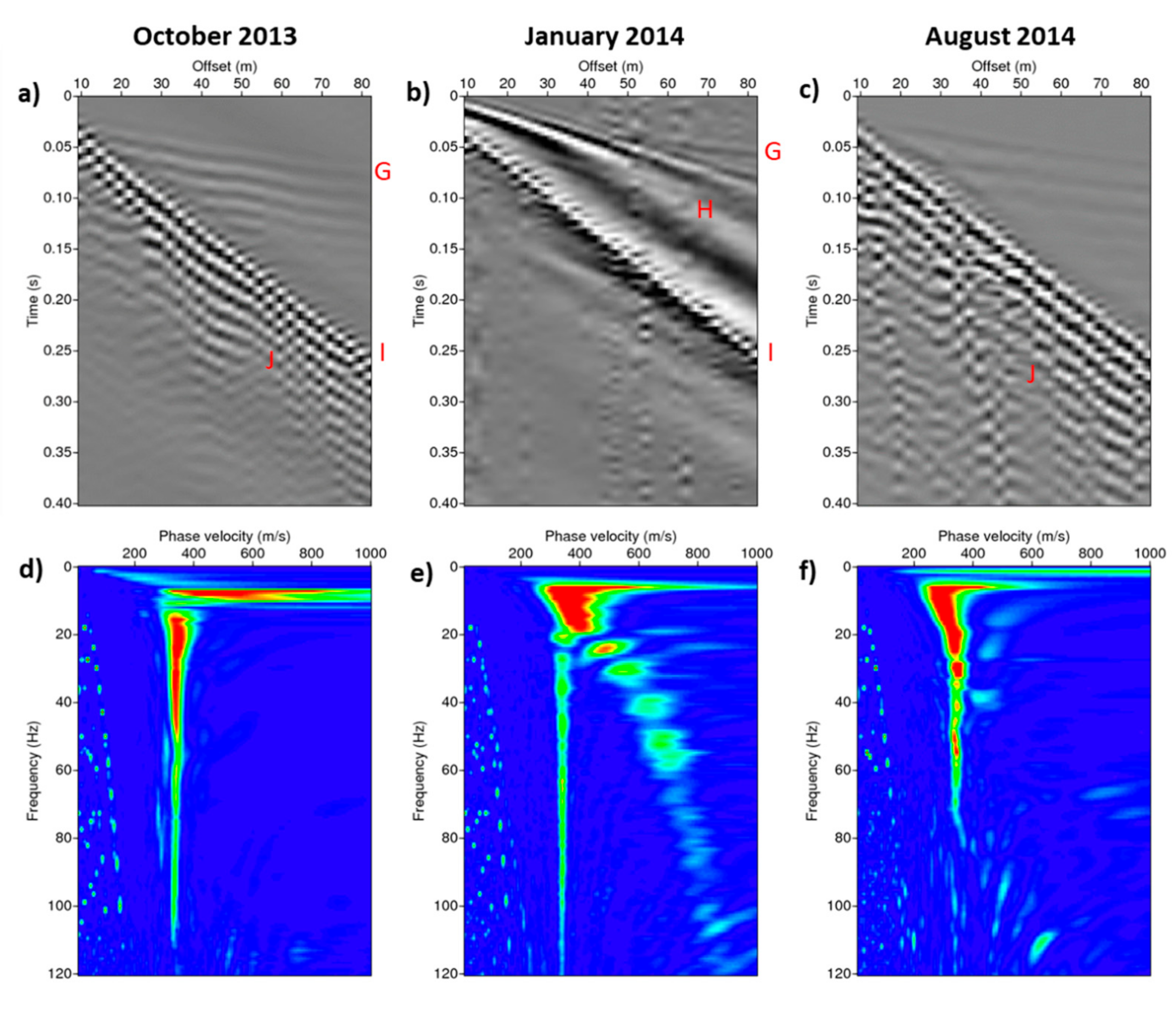
© 2020 by the authors. Licensee MDPI, Basel, Switzerland. This article is an open access article distributed under the terms and conditions of the Creative Commons Attribution (CC BY) license (http://creativecommons.org/licenses/by/4.0/).
Share and Cite
Stemland, H.M.; Johansen, T.A.; Ruud, B.O. Potential Use of Time-Lapse Surface Seismics for Monitoring Thawing of the Terrestrial Arctic. Appl. Sci. 2020, 10, 1875. https://doi.org/10.3390/app10051875
Stemland HM, Johansen TA, Ruud BO. Potential Use of Time-Lapse Surface Seismics for Monitoring Thawing of the Terrestrial Arctic. Applied Sciences. 2020; 10(5):1875. https://doi.org/10.3390/app10051875
Chicago/Turabian StyleStemland, Helene Meling, Tor Arne Johansen, and Bent Ole Ruud. 2020. "Potential Use of Time-Lapse Surface Seismics for Monitoring Thawing of the Terrestrial Arctic" Applied Sciences 10, no. 5: 1875. https://doi.org/10.3390/app10051875
APA StyleStemland, H. M., Johansen, T. A., & Ruud, B. O. (2020). Potential Use of Time-Lapse Surface Seismics for Monitoring Thawing of the Terrestrial Arctic. Applied Sciences, 10(5), 1875. https://doi.org/10.3390/app10051875




